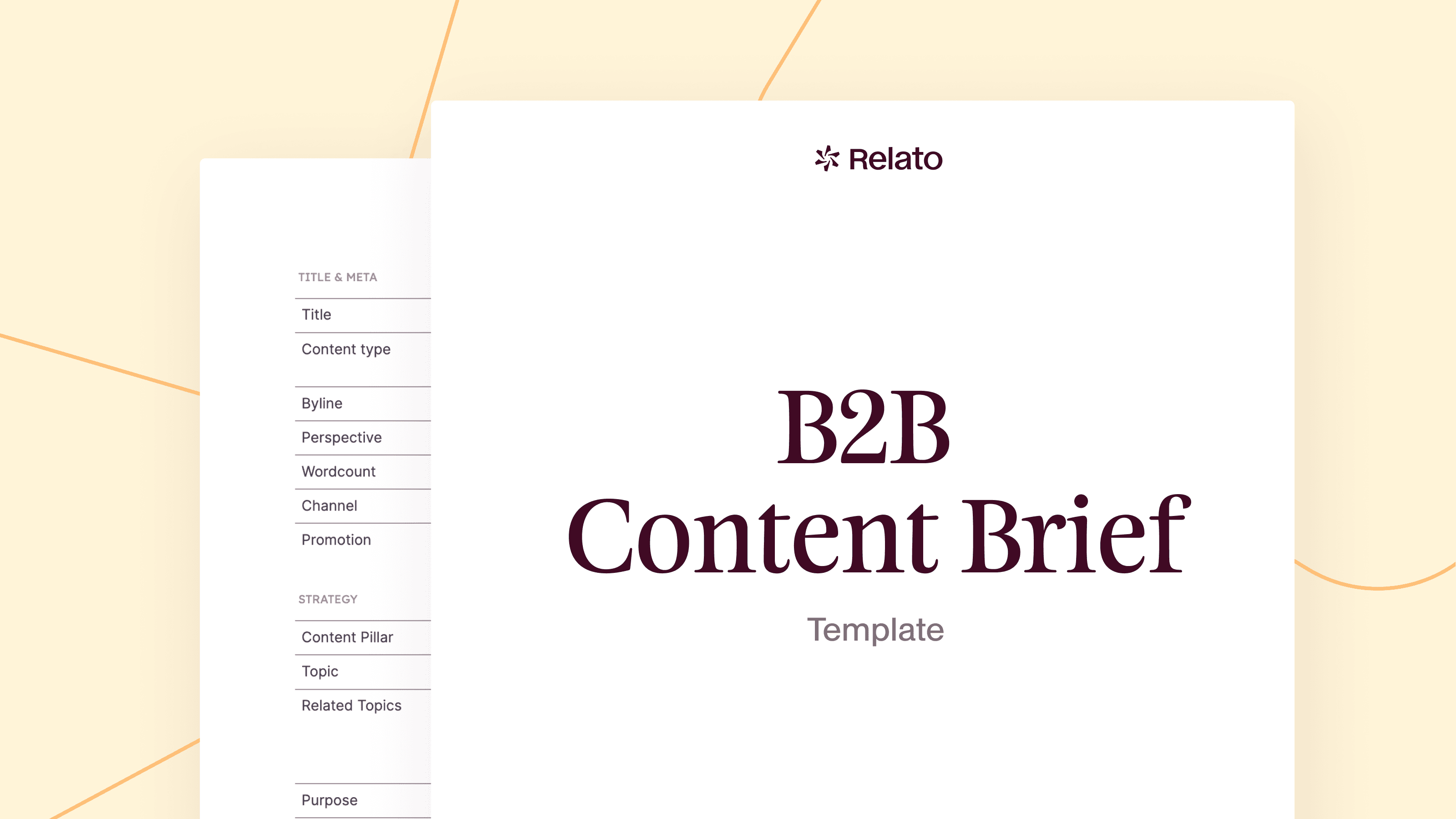

Get your copy of the B2B Content Brief Template
Is your content team often caught in a tangle of miscommunication and missed deadlines? A solid content brief is your ultimate tool to cut through the chaos and align everyone with precision and purpose.
Key Takeaways:
A comprehensive content brief cuts through confusion, providing everyone involved—from content creators to marketing strategists—with clear, actionable directions aligned with your project’s goals. It streamlines your content process, leading to more consistent, high-quality outputs that captivate and engage your target B2B audience. Every piece of content is crafted with intent, contributing effectively to your broader marketing objectives and effectively addressing the formal and complex procurement processes typical in larger organizations.
Ready to take your B2B content strategy to the next level? Download our ultimate B2B content brief template now and start crafting content that exceeds the expectations of a diverse and demanding B2B audience.
A good content brief removes all the guesswork. It outlines everything from the intended voice and style to the crucial SEO details, freeing up more time for creating impactful content. It acts as a blueprint, ensuring everyone starts on the same page—vital for navigating the complex and crowded B2B landscape, where multiple stakeholders influence every decision.
At Relato, we know that smoother processes produce better content. That's why we champion robust content briefs—they're key to using your resources wisely and capturing your audience's attention.
Ready to see how an effective content brief can revolutionize your workflow and elevate your content? Let's dive in and get your content creation process back on track!
The B2B Content Brief Guideline
Let's break down the ultimate B2B content brief—your roadmap to creating content that meets the mark and makes your audience crave more.
Title & Meta
Every great piece of content starts with the basics: who's writing it, what it's about, and where it will shine. Here's what you need to nail down:
Type | Description |
|---|---|
| Title | Your first handshake with the audience. Make it inviting and clear. |
| Content Type | Are we talking a blog post, an eBook, or something else? Match the format to your message. |
| Byline | Who gets the credit? This could be a single writer or the whole team. |
| Perspective | First-person or second-person? Decide how you want to chat with your reader. |
| Word Count | Keep it long enough to cover the topic, but short enough to keep it interesting. |
| Channel | Where is this masterpiece going to be published? Choose a platform that fits your audience's habits. |
| Promotion | How will you get eyes on your content? Think about where and how you'll promote it. |
Choosing the right content type and channel is crucial. For example, a detailed guide might work best as a downloadable eBook on LinkedIn if you're targeting professionals, while snappy tips might shine as blog posts shared via X.
Strategy
Diving deeper, your strategy is the compass that guides your content direction. Let's unpack this:
Type | Description |
|---|---|
| Content Pillar | What big topic does this piece support? Make sure it aligns with your broader goals. |
| Topic | This is the specific focus of your piece. What are you zooming in on? |
| Related Topics | Include a few areas connected to your main topic to broaden the reach. |
| Purpose | Why are you writing this? Always keep the end goal in mind. |
| Narrative Frame | What's the story here? How will you draw the reader in? |
| Brand Angle | How does this content reflect your brand's unique perspective or value? |
| CTA Placement | Where will you ask your reader to take action? Make it natural but noticeable. |
Imagine having a conversation with a room full of decision-makers, each with their own concerns and questions. In B2B, that's your audience. Tailoring your content to speak to everyone from tech gurus to executive leaders ensures your strategy hits the mark, steering clear of one-size-fits-all solutions.
Strategically aligning your content with business goals turns good content into great content. For example, if your goal is to drive sign-ups, your CTA should weave seamlessly into an article that solves a problem only your product can tackle effectively.
Target Audience
Understanding who you're to is half the battle won. Here's how to define your audience:
Type | Description |
|---|---|
| Primary Persona | Who is your main viewer or reader? Build a detailed profile of their interests and needs. |
| Secondary Persona | Don't forget the other folks who might drop by. Who are they? |
| Pain Points | What problems can your content solve for them? |
| Buyer Awareness | How much does your audience already know about the topic or your product? |
| Buying Committee | Tailor content to the varied roles within the buying committee—from IT managers to CFOs—each with specific interests and influence in the purchase process. |
Tailoring your content starts with knowing your audience's stage in the buyer journey. For someone new to the field, an introductory blog post might be the ticket. For a seasoned pro, a deep-dive white paper might hit the spot.
You also need to understand who is sitting at the buying table. Whether it's a tech specialist or a financial director, understanding the layers of a B2B buying committee allows you to create content that speaks directly to each persona's unique needs and moves the needle.
Research, Inspiration, & Resources
When creating standout content, digging into the right resources can make all the difference. Here's how to harness the power of both internal and external research:
- 1Internal Research: Start with what you already know. Dive into past content performance, customer feedback, and product data. What has resonated before? Use these insights as a springboard for new ideas.
- 2External Research: Look beyond your borders. What are thought leaders saying? Are there new studies or trends you can tap into? This fresh perspective can add depth and credibility to your content.
- 3Inspiring Content: Keep a pulse on content that catches your eye. Bookmark compelling articles, videos, or podcasts that inspire you. What hooked you? Try to capture that same magic.
- 4Podcasts and White Papers: These can be goldmines of information, offering in-depth insights on topics relevant to your industry. Use them to stay ahead of the curve and enrich your content with expert opinions.
To enhance content relevance and engagement, actively connect research insights to your audience's needs. For example, if a podcast discusses a challenge your audience faces, weave actionable solutions into your content. This boosts relevance and positions your content as a go-to resource.
B2B buyers don't just skim the surface—they dive deep, using around ten different channels to make informed decisions. Tap into this by grounding your content in solid research and credible sources, making your articles or guides a part of their extensive resource list.
SEO Considerations
SEO isn't just about getting to the top of search results—it's about making sure the right people find your content at the right time. Here's a breakdown of key SEO elements:
- 1Title: This is prime real estate for your primary keyword. Make it descriptive and compelling to both search engines and humans.
- 2Description: Your meta description should offer a clear, enticing summary of the content's value, incorporating your primary keyword naturally.
- 3Primary Keyword: Choose a keyword that reflects the core topic of your content. This should be a term your audience is actively searching for.
- 4Related SEO Strategies: Consider secondary keywords, semantic variations, and related phrases that can broaden your content's reach and relevance.
When integrating SEO, balance is critical. Start by ensuring your primary keyword fits naturally within your title and headings. Use secondary keywords throughout the body where they make sense contextually, but keep your reader's experience front and center. SEO should always support—not detract from—the quality and engagement of your content.
Content Structure and Linking Guidelines
Crafting a well-structured piece of content is like building a house—you need a solid blueprint and the right connections to ensure everything stands strong. Here's how to set up your content for success:
- 1Overview of Content Structure: Start with a clear introduction that sets the stage for your readers. Outline your main points in a logical sequence, ensuring each section flows smoothly into the next. Conclude with a strong summary or call to action that reinforces your key messages.
- 2Main Points: Identify the core ideas you need to cover. These should align with your content goals and answer your audience's most pressing questions.
- 3Must-Includes: Determine any critical information or regulatory requirements that must be included, such as disclaimers, data sources, or key facts.
- 4Organizing Content Effectively: Use headings, subheadings, bullet points, and paragraphs to break up text and make it digestible. Each segment should serve a purpose and bring the reader closer to your intended action or conclusion.
- 5Content Structure's Relation to Decision-Making: For B2B companies, especially the big players with formal buying processes, your content needs to do more than just inform. It has to align with their internal checklists and convince an entire committee. Structuring your content to address specific roles and compliance requirements can make all the difference.
To maximize SEO and user engagement, strategically place internal links to keep readers on your site longer and guide them to relevant content. External links should provide additional value or evidence, pointing to reputable sources. Be mindful of no-linking policies where confidentiality or data integrity issues arise.
Practical Tips and Common Pitfalls
Creating an effective content brief is more art than science, but there are some key do’s and don’ts to keep in mind:
Do:
- Be Clear and Concise: Use simple language to explain what is needed. Avoid jargon unless it’s industry-specific and necessary.
- Be Specific: Include detailed information on the content’s purpose, audience, tone, and structure. The more guidance you can provide, the better the outcome.
- Align With Strategy: Ensure every piece of content has a clear role in your overall marketing strategy. It should serve a specific business goal, whether it’s lead generation, education, or brand awareness.
Don’t:
- Overwhelm With Details: While specifics are good, too many can stifle creativity. Find the balance between guidance and flexibility.
- Ignore Feedback: Always be open to feedback from your content creators. They might offer insights that can significantly improve the brief.
- Set Unrealistic Expectations: Be realistic about timelines and outcomes. Consider your team’s capacity and the complexity of the content.
An effective content brief might detail the target audience, key message, desired action, and SEO keywords, while also allowing room for the writer’s creativity. An ineffective brief might be vague about the audience and goals, or overly prescriptive on the style, stifling the writer’s ability to effectively engage the target audience.
Conclusion
The power of a well-structured B2B content brief is game-changing. It's more than just paperwork—it’s the foundation of effective content creation, ensuring that each piece aligns perfectly with your strategic goals and resonates deeply with a sophisticated B2B audience.
A clear and thorough content brief becomes indispensable as B2B marketing continues to morph with decision-making involving an average of 10 different channels and buying committees ranging from 7 to 14 members.
It ensures that every piece of content serves a specific purpose, addressing the needs of each stakeholder involved in the buying process. From the initial awareness stage right through to the decision-making phase, your content can effectively guide and influence the buyer’s journey.
